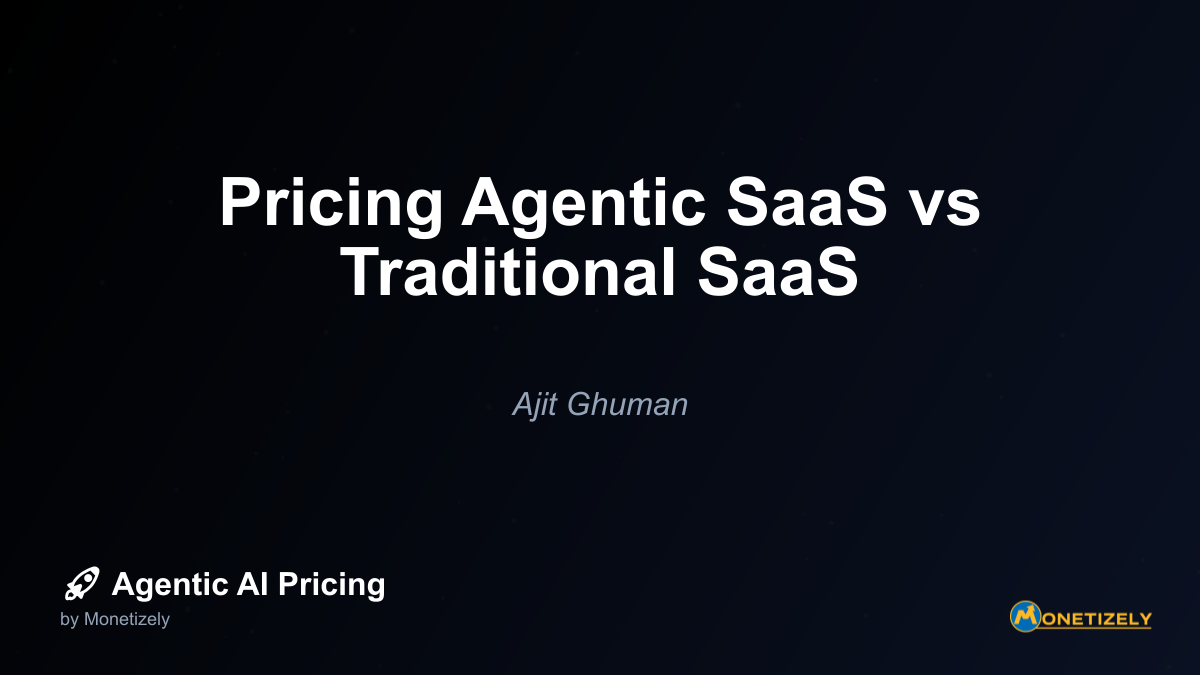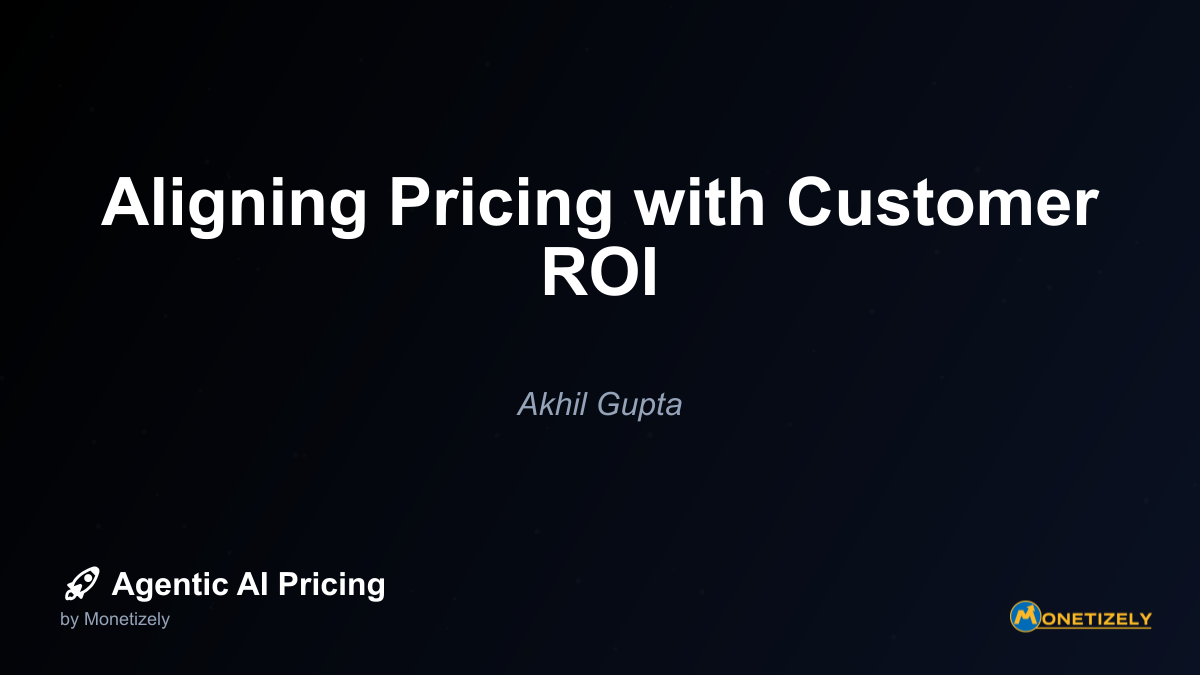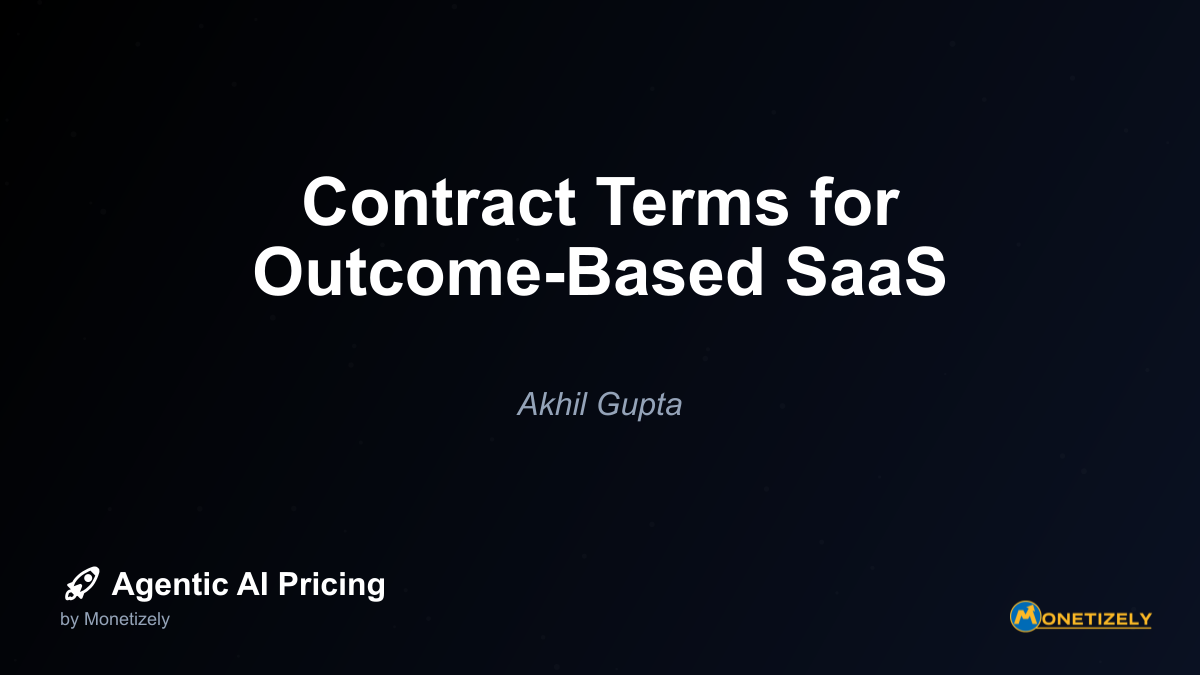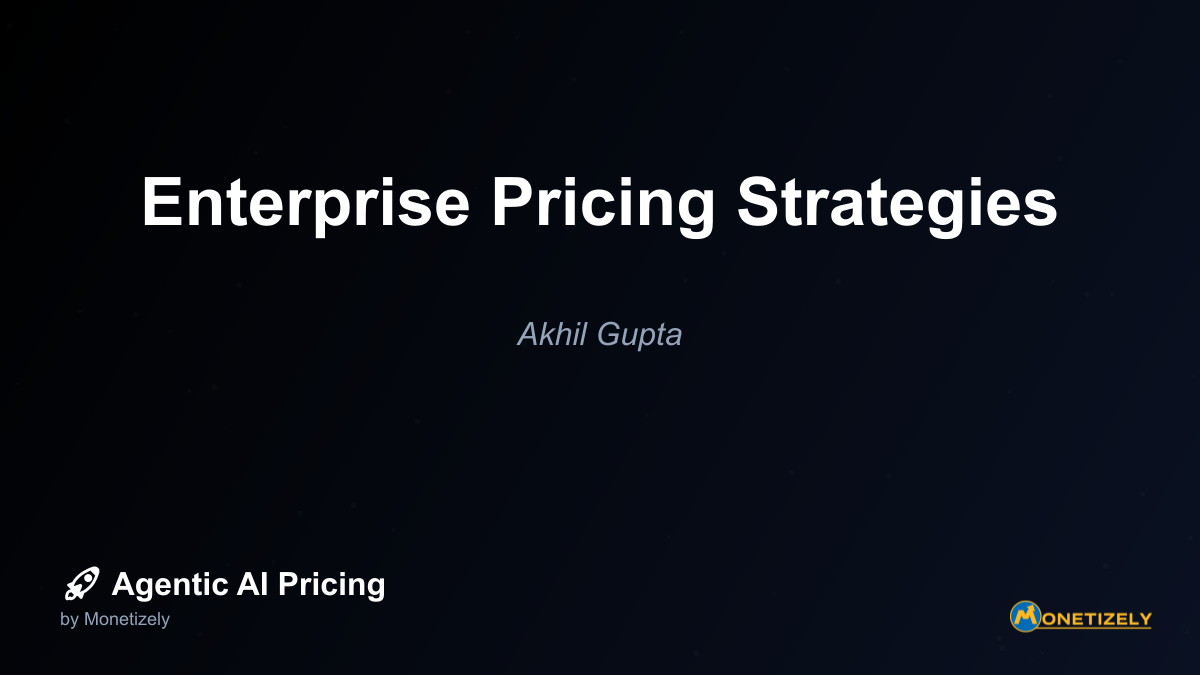· Ajit Ghuman · Pricing Agentic SaaS Products · 13 min read
Pricing Agentic SaaS vs Traditional SaaS
AI and SaaS Pricing Masterclass
Learn the art of strategic pricing directly from industry experts. Our comprehensive course provides frameworks and methodologies for optimizing your pricing strategy in the evolving AI landscape. Earn a professional certification that can be imported directly to your LinkedIn profile.

The traditional SaaS pricing paradigm has served the software industry well for decades, creating predictable revenue streams and scalable business models. However, the emergence of agentic AI is fundamentally disrupting these established frameworks. As autonomous AI systems increasingly replace human-operated software tools, companies are discovering that conventional pricing models no longer adequately capture the unique value proposition of these intelligent, self-operating solutions.
The Fundamental Shift: From Tools to Autonomous Actors
Traditional SaaS products function primarily as tools—digital instruments that require human operators to deliver value. In contrast, agentic SaaS solutions operate as autonomous actors, independently performing complex tasks with minimal human intervention. This distinction represents more than a mere technological evolution; it signals a profound transformation in how software creates and delivers value.
Defining Agentic SaaS
Agentic SaaS refers to software-as-a-service solutions powered by autonomous AI systems capable of:
- Independent decision-making within defined parameters
- Self-improvement through continuous learning
- Goal-oriented action without constant human direction
- Multi-step task execution across various domains
- Adaptation to changing environments and requirements
These capabilities fundamentally alter the relationship between the software and its users, transforming it from a tool that requires skilled operation to an intelligent assistant or even a replacement for human labor in specific domains.
The Architecture Divide
The architectural differences between traditional and agentic SaaS are substantial and have direct implications for pricing strategies:
| Aspect | Traditional SaaS | Agentic SaaS |
|---|---|---|
| Structure | Monolithic or microservices with static workflows | Modular, adaptive systems with dynamic integration capabilities |
| Customization | Requires significant reconfiguration | On-the-fly adjustments without disrupting system integrity |
| Workflow | Predetermined processes with limited flexibility | Dynamic, self-adjusting workflows that evolve with use |
| Integration | Typically requires API development or middleware | Can autonomously connect to and leverage other systems |
| Scalability | Often requires additional infrastructure or licensing | Can intelligently allocate resources based on needs |
These architectural differences create a new value proposition that traditional pricing models struggle to capture effectively.
Traditional SaaS Pricing Models: A Brief Overview
To understand why agentic SaaS requires new pricing frameworks, we must first examine the established pricing models in traditional SaaS:
Subscription-Based Models
The subscription model—typically charging per user per month—has been the cornerstone of SaaS pricing for decades. It offers predictable recurring revenue for vendors and manageable, consistent costs for customers. However, this model assumes that value scales linearly with the number of human users, an assumption that breaks down when AI agents can perform the work of multiple humans.
Feature-Tiered Pricing
Feature-tiered pricing segments offerings into packages with increasingly advanced capabilities at higher price points. While effective for traditional SaaS, this approach struggles when agentic AI can dynamically access and deploy capabilities based on contextual needs rather than predetermined feature sets.
Usage-Based Pricing
Usage-based pricing has gained popularity in recent years, charging based on consumption metrics like API calls, storage, or processing time. While closer to capturing value in an agentic context, traditional usage metrics often fail to reflect the business outcomes that autonomous AI systems deliver.
Freemium Models
Freemium approaches offer basic functionality for free while charging for premium features. This model faces challenges with agentic SaaS, as the line between basic and premium capabilities blurs when AI agents can creatively combine simple functions to achieve complex outcomes.
Why Traditional Pricing Models Fall Short for Agentic SaaS
Several fundamental factors make traditional pricing models inadequate for agentic SaaS solutions:
1. Autonomy Levels Transcend User Counts
Traditional per-seat licensing assumes human operators as the primary value unit. However, agentic SaaS can operate independently, making the number of human users an increasingly irrelevant metric for measuring value. A single AI agent might perform tasks that previously required dozens of human users, rendering per-seat pricing models obsolete.
As the CEO of Tractable notes, “When your software delivers outcomes autonomously, the pricing challenge shifts from tool access to measuring autonomous value delivered.”
2. Resource Consumption Patterns Differ Dramatically
Agentic AI systems exhibit resource consumption patterns that differ significantly from traditional SaaS:
- API Access Requirements: One API key per agent rather than per customer, potentially requiring 100-1000x more keys than traditional models
- Consumption Units: Activity limits based on human-equivalent tasks (e.g., deals processed per day) rather than raw compute usage
- Resource Scaling: Non-linear resource utilization that fluctuates based on task complexity and learning requirements
These differences make traditional usage-based pricing models, which typically measure simple metrics like storage or processing time, inadequate for capturing the true resource utilization and value delivery of agentic systems.
3. Value Creation Mechanisms Are Fundamentally Different
Traditional SaaS creates value by automating specific tasks based on static workflows. In contrast, agentic SaaS generates value through:
- Adaptive problem-solving that evolves with experience
- Proactive identification of opportunities and issues
- Creative combination of capabilities to achieve novel solutions
- Continuous improvement without manual updates or training
These value creation mechanisms are poorly captured by traditional pricing models that focus on access to features or simple usage metrics rather than outcomes achieved.
4. Customer Expectations Have Shifted
As customers become more sophisticated in their understanding of AI capabilities, their expectations are evolving:
- From tool access to outcome delivery
- From paying for features to paying for results
- From fixed capabilities to continuous improvement
- From operational efficiency to strategic advantage
These shifting expectations demand pricing models that align more closely with the business outcomes that agentic SaaS delivers rather than the traditional metrics of seats, features, or basic usage.
Emerging Pricing Models for Agentic SaaS
In response to these challenges, several innovative pricing models are emerging that better align with the unique value proposition of agentic SaaS:
1. Agent-Based Pricing
Agent-based pricing charges customers per AI agent deployed, often as a subscription or one-time license fee. This approach mirrors the concept of “digital labor,” effectively equating pricing to salary-cost-like metrics.
Real-World Example: Nullify implements agent-based pricing, charging customers $800 per AI agent per year for continuous security vulnerability scanning and remediation. This model provides budget predictability for customers who can reallocate human labor budgets to AI agents.
Key Considerations:
- Aligns with the concept of AI as digital labor
- Provides predictability for both vendor and customer
- May transfer risk to customers if agents are idle or underutilized
- Works best when agents perform broad, ongoing tasks similar to human employees
2. Outcome-Based Pricing
Outcome-based pricing ties costs directly to measurable business outcomes or performance improvements enabled by the agentic SaaS solution. This approach aligns payment with achieved value rather than access or usage.
Real-World Example: Salesforce and Zendesk have implemented outcome-based pricing for their support automation solutions, charging customers only when an AI agent successfully handles a case or conversation. Zendesk reports a 30% increase in customer satisfaction scores partly attributable to this pricing model that fosters adoption by aligning cost with realized value.
Key Considerations:
- Creates perfect alignment between vendor and customer incentives
- Reduces adoption risk for customers
- Requires sophisticated metrics for value quantification
- May create cash flow unpredictability for vendors
- Demands clear attribution methodology to isolate AI impact
3. Resource-Based Usage Pricing
Resource-based usage pricing charges strictly for the computational or AI resources consumed, such as cloud compute or large language model (LLM) calls. This approach offers high flexibility but limited cost predictability.
Real-World Example: Microsoft Copilot adopts a per-activity (metered) pricing model, charging customers based on “Security Compute Units” used, reflecting the actual AI resources consumed for security tasks. Similarly, Devin charges per “Agent Compute Unit” for its AI software assistant services.
Key Considerations:
- Enables fair cost matching to actual AI resource use
- Limits budgeting certainty for customers
- Often favored during pilot phases to manage AI operational costs
- May lose favor at scale as cost predictability becomes more important
4. Performance Tier Pricing
Performance tier pricing offers different levels of AI capability, autonomy, or performance at tiered price points. This approach bridges traditional feature-tiered models with the unique capabilities of agentic systems.
Key Considerations:
- Familiar structure for customers accustomed to traditional SaaS pricing
- Allows for clear differentiation based on capability levels
- May artificially constrain AI performance to maintain tier integrity
- Can create unnatural boundaries in what should be a continuous capability spectrum
5. Hybrid Models
Hybrid models combine elements of the above approaches to balance flexibility, predictability, and value alignment. These models are increasingly popular as they can adapt to different customer preferences and use cases.
Real-World Example: Amazon leverages a hybrid pricing approach for its agentic AI solutions, combining elements of dynamic pricing, outcome-based models, and resource consumption. This approach has helped Amazon achieve a 2-5% increase in margins and 10-20% reduction in inventory costs through optimized pricing and inventory management.
Key Considerations:
- Offers flexibility to adapt to different customer needs and preferences
- Can balance vendor and customer risk appropriately
- May create complexity in communication and implementation
- Allows for evolution of pricing as the market matures
Implementation Challenges and Technical Considerations
Implementing effective pricing models for agentic SaaS involves addressing several significant challenges:
1. Measurement and Attribution Complexity
Outcome-based and performance-based pricing models require sophisticated measurement systems to track results and attribute them accurately to the AI’s actions. This can be particularly challenging when:
- Multiple factors influence outcomes
- AI works alongside human operators
- Results materialize over extended periods
- Counterfactuals are difficult to establish
Developing robust attribution methodologies and measurement frameworks is essential for implementing value-aligned pricing models.
2. Integration and Infrastructure Requirements
Agentic SaaS solutions typically require extensive integration with existing enterprise systems, which can be costly and technically challenging. Pricing models must account for:
- Implementation costs and complexity
- Infrastructure requirements for agent orchestration
- Context management across multiple agents
- Analytics capabilities for performance tracking
These technical considerations influence not only the pricing structure but also the overall value proposition and total cost of ownership.
3. Resource Consumption Predictability
The resource consumption patterns of agentic AI can be highly variable and difficult to predict, creating challenges for both vendors and customers in budgeting and capacity planning. Effective pricing models must address:
- Unpredictable costs of large language models and AI compute resources
- Variable resource needs based on task complexity
- Scaling requirements during learning phases
- Balancing cost predictability with fair resource allocation
Striking the right balance between predictability and flexibility is crucial for sustainable pricing models.
4. Regulatory and Compliance Considerations
As regulatory frameworks for AI evolve, pricing models must adapt to incorporate compliance costs and risk management. Key considerations include:
- Transparency requirements for AI decision-making
- Data privacy and security regulations
- Industry-specific compliance needs
- Liability allocation for AI actions and decisions
Building these considerations into pricing structures ensures long-term sustainability as the regulatory landscape matures.
Strategic Framework for Developing Agentic SaaS Pricing
Based on emerging best practices and market trends, the following framework provides a structured approach to developing effective pricing strategies for agentic SaaS solutions:
1. Value Mapping
Begin by mapping the specific value that your agentic SaaS creates for customers:
- Efficiency Value: Time and resource savings
- Quality Value: Improved outcomes and reduced errors
- Strategic Value: New capabilities and competitive advantages
- Innovation Value: Novel solutions and continuous improvement
Understanding these value dimensions is essential for designing pricing models that align with customer perceptions of worth.
2. Autonomy Assessment
Evaluate the level of autonomy your solution provides across different dimensions:
- Decision Autonomy: Ability to make independent decisions
- Execution Autonomy: Capability to act without human intervention
- Learning Autonomy: Capacity for self-improvement
- Collaboration Autonomy: Ability to work with humans and other systems
Higher levels of autonomy often justify more sophisticated pricing models that capture the full value delivered.
3. Resource Analysis
Analyze the resource requirements and consumption patterns of your agentic solution:
- Compute Resources: Processing, memory, and storage needs
- AI Model Costs: Expenses related to large language models or other AI systems
- Integration Resources: Requirements for connecting with other systems
- Support Resources: Human oversight and intervention needs
This analysis helps establish the cost floor for your pricing strategy while identifying opportunities for efficiency improvements.
4. Outcome Definition
Clearly define the measurable outcomes that your solution delivers:
- Quantitative Metrics: Specific, measurable results (e.g., 30% faster processing)
- Qualitative Improvements: Enhanced experiences or capabilities
- Time Horizons: When outcomes can be expected and measured
- Attribution Methodology: How to isolate the AI’s contribution
Well-defined outcomes are essential for implementing value-based pricing models that align costs with results.
5. Customer Segmentation
Segment your customer base according to value perception, risk tolerance, and usage patterns:
- Value Seekers: Focused on ROI and business outcomes
- Predictability Seekers: Prioritizing budget certainty and risk management
- Flexibility Seekers: Valuing adaptability and scalability
- Performance Seekers: Demanding maximum capability regardless of cost
Different segments may require different pricing approaches or hybrid models that address diverse needs.
6. Pricing Model Selection and Calibration
Based on the above analyses, select and calibrate the appropriate pricing model(s):
- Agent-Based: Calibrate agent pricing to reflect the human equivalent value
- Outcome-Based: Set pricing percentages based on value captured
- Resource-Based: Establish fair margins above resource costs
- Performance Tier: Define clear capability differentiators between tiers
- Hybrid: Balance predictability and value alignment across components
The selected model should align with your solution’s value proposition, customer expectations, and business objectives.
Future Trends in Agentic SaaS Pricing (2024-2025)
As the agentic SaaS market matures, several important trends are emerging that will shape pricing strategies in the coming years:
1. Shift Toward Value-Based Models
Analysts predict a continuing shift from resource-based and agent-based pricing toward more sophisticated value-based and outcome-based models. As measurement methodologies improve and customers become more comfortable with these approaches, they are likely to become the dominant paradigm for high-value agentic solutions.
2. Regulatory Impact on Pricing Structures
Emerging AI governance frameworks will increasingly influence pricing strategies, particularly in regulated industries. Blockchain integration for immutable audit trails and hybrid deployment models balancing cloud with on-premises security will become important components of pricing and deployment strategies.
3. Ecosystem-Based Pricing
As agentic AI ecosystems develop, pricing models that account for network effects and ecosystem participation will emerge. These approaches will value not just individual agent performance but also contributions to and benefits from broader AI ecosystems.
4. Dynamic Pricing Optimization
Agentic AI itself will increasingly be applied to optimize pricing strategies, creating more dynamic and personalized pricing models that adapt to individual customer value profiles and usage patterns.
5. Convergence with Human Labor Models
As agentic AI increasingly substitutes for human labor, pricing models will continue to evolve toward structures that mirror human compensation, including performance bonuses, advancement tiers, and outcome-based incentives.
Case Studies: Successful Agentic SaaS Pricing Implementations
Amazon’s Dynamic Pricing and Inventory Management
Amazon leverages agentic AI for dynamic pricing and inventory management, continuously adjusting prices based on competitor actions, demand, and customer behavior. This approach has generated significant ROI:
- 2-5% increase in margins through dynamic price adjustments
- 10-20% reduction in inventory costs through optimized forecasting
- Enhanced competitive positioning through real-time market responsiveness
The pricing model combines resource-based components with outcome-based elements, creating a balanced approach that scales with value delivered.
SuperAGI’s Sales Outbound Solution
A tech enterprise using SuperAGI’s AI agents for outbound sales implemented a hybrid pricing model combining subscription and performance components. The results were impressive:
- 35% increase in demo requests
- 27% rise in proposal submissions
- Reduction of sales cycle from 120 to 90 days
- 12% cut in sales and marketing expenses, saving approximately $230,000 per quarter
This translated into higher sales productivity (+25%) and shorter sales cycles (-15%), demonstrating the potential of well-aligned pricing models to drive adoption and value realization.
Zendesk’s Support Automation
Zendesk’s implementation of outcome-based pricing for its support automation solution demonstrates the power of aligning costs with value delivered:
- 30% increase in customer satisfaction scores
- Higher adoption rates due to reduced implementation risk
- Clear ROI measurement through successful case resolution metrics
- Improved alignment between vendor and customer incentives
This approach has become a model for outcome-based pricing in the customer service automation sector.
Practical Recommendations for Executives
Based on the analysis of emerging models and implementation challenges, executives should consider the following recommendations when developing pricing strategies for agentic SaaS solutions:
For CEOs and Strategic Leaders
- Focus on value alignment rather than traditional metrics like users or seats to avoid undervaluing a
Co-Founder & CEO
Ajit is the author of Price To Scale, a top book on SaaS Pricing and is the Founder of Monetizely. Ajit has led and worked in pricing and product marketing at firms like Twilio, Narvar and Medallia. His work has been featured in Forbes and VentureBeat. Ajit regularly consults with software companies from Seed stage to post-IPO on pricing strategy. Ajit is also a highly-rated co-instructor for 'The Art of SaaS Pricing and Monetization' on Maven.
Pricing Strategy Audit
Let our experts analyze your current pricing strategy and identify opportunities for improvement. Our data-driven assessment will help you unlock untapped revenue potential and optimize your AI pricing approach.




